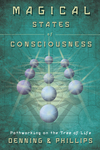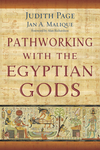Using Imagination to Cure Psychological Complexes

The rationalist culture of the post 19th century has done its best to kill imagination. To the pure materialist, imagination is just day-dreaming and an unnecessary barrier to achieving.
More recently, science seems to be reviewing its views with some physicists, like David Bohm and Karl Pribram, starting to think that the entire universe might be like a hologram where the mind and imagination play a key role in what happens.
The esoteric tradition has been using imagination techniques for centuries to explain and create the various strange things people on its path experience.
Since the 1960s, the concept of pathworking, or imagination journeys, in the hope to attain some form of spiritual experience, has become common amongst many Wiccan and hermetic groups.
In the mid-1990s, a group of ceremonial magicians based near London decided to experiment with pathworking as a way of changing their physical and psychological environments. The premise was that if the universe was built by thought, then imagination could be the key to changing its construction.
The group, of which I was a member, were trained within the Servants of the Light school of Magic which emphasized the use of pathworking as its most important training technique. Being interested in psychology and counseling, we were intrigued to establish a link between imagination and psychological complexes.
Long before any of us had read of holographic universes, we reasoned that if our worlds were an extension of our minds, then neurotic complexes which fascinated Freud and Jung would have a negative effect on our material world. More importantly, pathworking could be a method for disabling those complexes, effectively quickly curing them.
The first technique we developed was the Inner Kingdom. This was a magic mirror that was created by the imagination of the person, and it could be used as a diagnostic tool to give you a look into the person's psyche.
Basically we would give a person a basic outline of a Celtic village that they are supposed to rule. We would ask them to fill in details of what they saw of this village, and then interpret them in much the same way you would a dream. We reasoned that like a dream, the unconscious mind would try to communicate with the waking mind through the scenario.
At the center of the whole thing was the Hall of the Hero, which represents the person's inner state. We based it on the cabalistic Tree of Life design because it fitted within the esoteric training we had.
In theory, it was a throne room from which they were supposed to rule their warriors (areas of personal activity) and outer world. However, we found that some people discovered that their Hall was empty, or that they were lacking some key elements. Some very stressed and busy people found that their warriors made too much noise and had to be silenced.
One thought it was important that the room dedicated to her partner should be placed behind her instead of the room dedicated to the "God" (which has a connection to the archetype of the father), and her parents should really be in those front rooms where she could see them. Psychologically what she was saying was that she felt the need to "replace" her father with her partner and place the role models of her parents in full view, instead of in the shadows behind her where they belonged.
Another woman found her Hall plagued by ghosts that haunted from the room that was dedicated to the Mother Goddess, and haunted the room that was supposed to represent her love match. In other words, she was experiencing problems relating to the bad programming which came from her Mother.
After having some success with this, we went outside the hall and got those taking part to describe their "village" This was supposed to be how they reacted to friends, family and work. One man, who had trouble with a workplace bully, found that giants kept raiding the village and destroying buildings. In one raid they smashed a hole in the side of the Hall of the Hero.
In both the Hall of the Hero and the Village scenarios, we experimented with changing images that we saw into more positive ones. Much to our surprise, there was a dramatic effect on the person's material world over the months that followed.
The person who had been attacked by the workplace bully arranged the villagers to firstly repair his hall, strengthen the village walls and then staged an imaginary attack on the giants, capturing them and forcing them to work for the good of the Kingdom.
In the "real world," he found that a mystery illness, which had been sapping him of energy for months, suddenly cleared up and he found himself at the center of an employee revolt against the bully. A group of employees approached the Human Resources Manager, who forced the bully to undergo various counseling programs. The bullying stopped and the man started to enjoy his work.
But the effects were not always "positive" in the "they all lived happily ever after" sense. One married couple suddenly discovered that the reasons they were together were not actually based on love, but a desire to mimic the disasters of their parents. Another found that his hatred of women was based on a long forgotten form of child sexual abuse; another Pagan found that his early Christian upbringing was still having a dramatic effect on the sort of relationships he was choosing.
However, there was a feeling that although the system was dramatic, it only seemed to work effectively for occultists, meditators or new agers, or those who readily accepted a more symbolic approach to life. To lay people, it did not directly tap into "reality."
Without realizing it, we came to the same conclusion that some therapists have about using hypnosis to cure phobias and complexes, i.e., the fact that the hypnotic state was too removed from reality limited the person's ability to change. They didn't really believe that it was affecting them.
An occultist might accept the powerful symbols they were using because they had been trained to use and believe in them, whereas a lay person did not have this belief.
To get around this problem, we worked out a system called the Tree. This was an Inner Kingdom which downplayed the symbolic, but dealt with issues in a much more direct way. The person would enter a symbolic garden which was supposed to reflect their inner state. They would find a tree, which represented the complex, that was sucking the life out of their environment. Along with a guide, they would enter the tree and visit various rooms within it. Each room represented a scene from their life where the complex had manifested. The person would be encouraged to participate in this scene and later correct it so that the scene never happened.
These experiences were perceived by the person as extremely realistic. Often, they would become genuinely angry or tearful (it was a standard requirement that each session have large box of tissues on hand). Each room would take the person back ever further in time to the earliest manifestations of the complex.
Finally, they would be taken in their imagination to the roots of the tree into a cave, where in the darkness they would be given a symbolic scene that represented the whole complex. One of the most chilling scenes for one over-achieving woman was of a "good little girl" skipping towards her. As the girl got closer, she felt colder and unable to do anything.
After the symbolic scene was resolved, a seed was planted in the dark cave and a rose bush started to grow as the tree collapsed. The person sat in the center of the rose as it rose up through the collapsing complex. When they emerged back into the garden, they found that the rose bush had replaced the tree and that all was well again.
To do all this, deep hypnosis was impossible, as it was vital that the person interact with the counselor. We would just get the person to relax and describe their imaginings with their eyes shut. The reality of what they were experiencing soon took over, and as the scene was described, the counselor was able to "follow" with their imagination.
This technique really did stir things up. It seems that if you removed one neurosis, like a house of cards, much of a person's world view came crashing down with it. The initial result of the technique is an initial feeling of empowerment, as energy trapped in the neurotic complex is freed. This is followed by a sense of purpose for the future, and then sometimes an urge to return to the safety of the past. Sometimes there was a sense of depression, as the road map for life felt altered, and the things that gave you joy were suddenly tasteless shadows.
In alchemy, this period is called nigredo, which, according to the great 16th century Alchemical text The Rosary of the Philosophers, is when the brain turns black. Alchemy describes, in horrible terms, what this feels like by using the imagery of rotting corpses. From this mass of depression rises the buds of something greater, which the Alchemists called "Whitening," where the blackness is purified. Fortunately for us, the nigredo period following the Tree technique was rarely as bad as what was described by the Alchemists, because the technique was only focused on one aspect of the psyche rather than the complete personality.
All of us in the group had our lives changed by the experiments we did. We have all moved on, and have been fairly successful afterwards. I continued to use the technique when counseling patients, and have passed it on to some of my friends in the counseling community who have used it to good effect. Last year, I decided to publish the technique and the various discoveries that we made into pathworking, because I felt that not only would others benefit from the technique, and several of the other techniques we worked out along the way, but it would also lead others to experiment with imagination and pathworking. I also felt that if people knew more about the powers of pathworking and how to do it effectively, it would encourage more research into this effective form of magical work. This book is Magical Pathworking.
Recently, having read The Holographic Universe by Michael Talbot, I have also started to wonder if what we were doing during that period was using our imaginations to jump between alternate realities—effectively choosing whatever Holographic Universes that contained the destinies we wanted. This seems less far fetched than it would appear. When you compare where every one in the group was at the time, and what we were doing at the time with what we are doing now, everyone is in a completely different place, beyond our wildest imaginations at the time.
Pathworking proved to me that the Universe is a lot more plastic than it appears, and imagination might be the key to unlocking those hidden powers within. When we master this skill, we really will be stuff that dreams are made of.
Related Products



is subject to certain Terms and Conditions